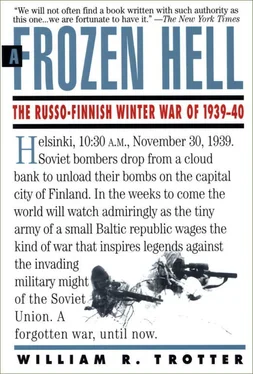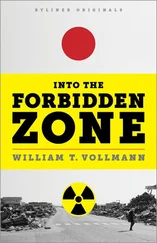4. The Russian Fifty-fourth Division, led by Major General Gusevski, attacked toward Kuhmo with 12,800 men, 120 pieces of artillery, and 35 tanks. Opposing their advance was a ragtag force of Finnish border guards and reservists numbering about 1,200.
5. Just south of the Kuhmo thrust, the Russian 155th Division attacked toward Lieksa, with 6,500 men, 40 guns, and a dozen tanks. Opposing it were two Finnish battalions, about 3,000 men, and 4 light, obsolete field guns.
SHIPS AGAINST FORTS
While the campaigns on land were gathering momentum, there was a flickering, shadowy naval war going on in the Gulf of Finland and adjacent waters. It was an interesting sideshow, but it did not amount to very much. There were two reasons for that. The first and most obvious is the fact that by the end of December, the Gulf of Finland had started to freeze into a vast sheet of ice. The other reason is that the navies involved did not amount to very much, either.
If there was such a thing as an “elite” force in the Red Navy of 1939, it was the Baltic Fleet—but that was not much of a distinction. The Red Navy was strictly a provincial coast defense force at that time, and technologically it was about a quarter-century behind either the Royal Navy or the German Kriegsmarine. The Baltic Fleet did occupy several of the disputed gulf islands, but these operations were unopposed. It did not have the training, the logistical structure, or the landing craft to undertake large-scale amphibious operations. Nor was it blessed with a commander in chief of strategic vision. Some idea of Stalin’s competence as a naval strategist can be derived from his insistent attempts to persuade his Baltic Fleet commanders to attack Turku harbor with submarines, even though they kept pointing out to him, with words, maps, and aerial photos, that the approaches to that harbor were so shallow and strewn with reefs that no submarine could possibly survive long enough to reach a firing position.
The Finnish Navy, 13,000 men, was strictly a coast defense force. There were a dozen or so modern PT boats, some mine warfare vessels, a number of shallow-draft gunboats (some of them dating back to the tsarist era), four small submarines, and two big ships that could be described as cruisers or monitors, depending on whether one looks at their design or their function. They were named Väinämönen and Ilmarinen , after two popular heroes in the Kalevala , the Finnish national epic, and they had been the pride of the prewar government. They were handsome ships, and for their weight they packed considerable firepower. The one and only English-language description of these ships ever to see print states that their main batteries were 105 mm. guns, but no one ever built a cruiser-sized ship to carry such relatively puny weapons. Extant Finnish photographs clearly show a more powerful battery, and the 1940 edition of Jane’s Fighting Ships confirms that the main guns were eight-inch, backed up by secondary guns of four-inch caliber and at least a half-dozen Bofors guns for antiaircraft protection.
It is hard to fathom why the Finnish government spent millions of marks on these ships when their deterrent value against the infinitely stronger Baltic Fleet would have been marginal at best, and when the same amount of money could have doubled the number of modern fighter planes in the air force or gone a long way toward correcting some of the field army’s chronic weaknesses. These two curious vessels did brave work during the Continuation War as mobile heavy artillery, pounding Russian targets all along the Karelian Isthmus, but during the Winter War their contribution was minimal: their antiaircraft guns knocked down one or two planes over Turku harbor. Otherwise, they remained icebound for the duration of the conflict.
Most of the naval action took place in the form of classic ship-to-shore gunnery duels. The Finnish coastal artillery was something of an elite force; many of its guns were old, but they were expertly sited, powerful, and manned by keen, disciplined crews.
On December 1, the Soviet cruiser Kirov , escorted by two large destroyers, took on the defenses of Hanko and lost the exchange. The battle was fought under hazy conditions, so details of it are sketchy, but it is certain that one Russian destroyer, closing range recklessly, took at least one large caliber hit, sheered abruptly out of formation, and limped out to sea behind a cloud of smoke. The Kirov had trouble getting the range of the Hanko batteries and did them no significant damage, whereas the Finns were soon straddling it with water spouts. At least one, and possibly two, Finnish shells struck the cruiser on its stern and seriously damaged it. After retiring out of range the Kirov lost engine power and had to be towed back to its base at Tallin, Estonia.
Another duel, about two weeks into the war, took place in the skerries outside of Turku. Two Russian destroyers (possibly the Gnevny and the Grozyaschi) engaged batteries on Uto Island. Again, Russian fire was ineffective (and, again, one must question the competence of any naval commander who orders two destroyers to tackle a battery of ten-inch coast artillery on their own). A single Finnish shell dropped squarely amidships on one of the destroyers; both ships broke off firing after only ten minutes, made smoke, and retired. Ten minutes later the torpedo magazine of the damaged destroyer exploded, breaking the ship in two and causing it to sink in less than two minutes, with heavy loss of life.
The most dramatic of these engagements took place on December 18 and 19, just a week or so before ice brought all naval activity to a halt. The Russian battleship Oktyabrskaya Revolutsia sailed boldly close to the Saarenpää batteries on Koivisto Island, perhaps the most effective Finnish artillery position of the war. The bombardment was preceded by a heavy air attack, which threw up spectacular clouds of dust but did little material damage. Shortly after noon, the Russian battleship hove into range, escorted by five destroyers and a spotting plane. Two Finnish Fokkers were scrambled to nail the spotter plane, but the overzealous and highly accurate Koivisto antiaircraft gunners shot one of them down. Its pilot, Eino Luukkanen, managed to crash-land and walk away uninjured; he later became Finland’s third-ranking ace. By the end of the Continuation War in 1944, he would shoot down a total of fifty-four Russian aircraft.
On this day, the Finnish guns were having trouble; one by one they fell silent after only ten minutes’ fire. The battleship got closer, and its 305 mm. shells began causing casualties and damage. After furious exertions the Finnish gunners managed to get a single ten-inch rifle back in firing order, and their first few shots landed close alongside the Russian ship. The captain decided enough was enough, ordered the helm thrown over sharply, and retired out of range.
The following day, the older battleship Marat , heavily escorted by destroyers and light cruisers, returned to plaster the Saarenpää batteries. The Finnish commander had ordered his men to reply with only one gun at a time so that a slow but steady fire might be kept up even if weapons went out of whack again. The Russians’ gunnery on this occasion was excellent—the Saarenpää site was hit by about 175 rounds, all its buildings were flattened, and the forest cover was stripped away from its battery positions.
With icy deliberation, the Finns replied with one shot at a time, seemingly to no effect. Then, just as the battleship was approaching truly lethal range, a dark column of water heaved up alongside its hull, followed by a cloud of smoke, which made precise observation difficult. Although no fires were observed, the Marat hurriedly retired without further combat, indicating that it had taken a hit near the waterline.
Читать дальше












